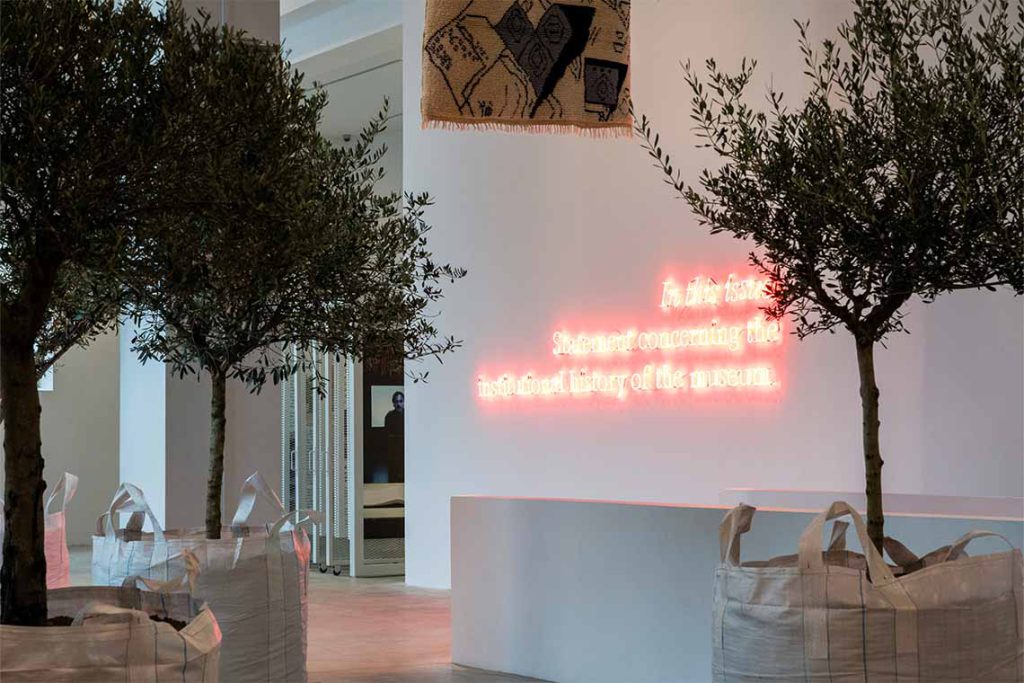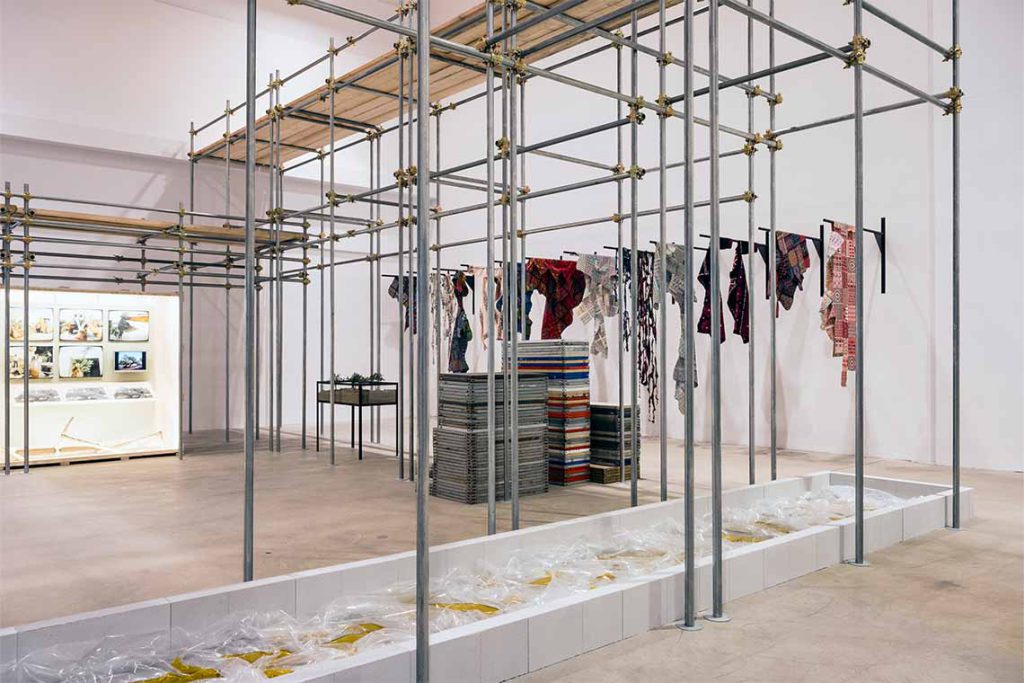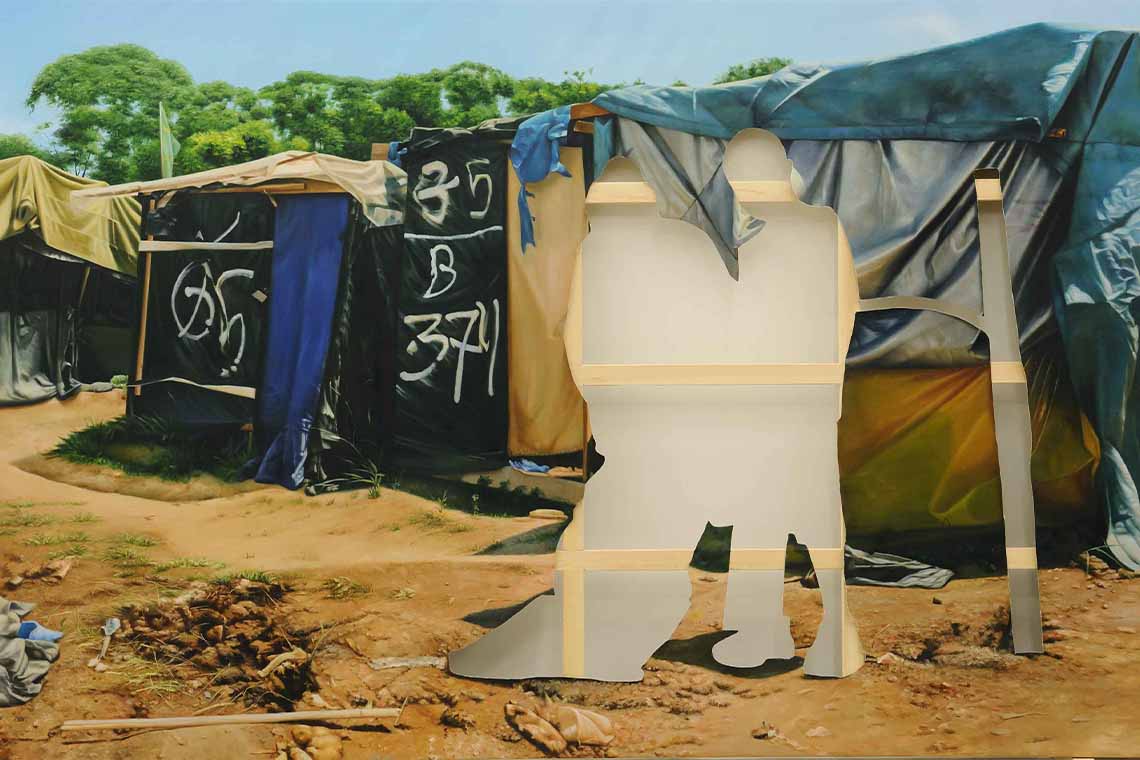In Through the Palestinian Museum of Natural History and Humankind, artist and curator Khalil Rabah brings his eponymous nomadic installation into Fondazione Merz, critiquing power structures and rewriting cultural narratives from within the institutional context.
Three weeks before Khalil Rabah’s exhibition Through the Palestinian Museum of Natural History and Humankind opened at Fondazione Merz in Turin, longstanding tensions between Palestine and Israel erupted as Israel declared war on Hamas. Despite the resultant killing of Palestinian civilians and mass displacement of the population across Gaza, the world continues to watch as calls for a permanent ceasefire are largely ignored.
Khalil Rabah looks weary when inevitably asked about how the show is now contextualised in light of the conflict. For decades he has endeavoured to preserve Palestinian culture and rewrite marginalised histories, and is therefore reluctant to now position his work purely in response to this crisis.
“I am an artist,” he deflects, going on to explain how the concept behind his museum has remained consistent ever since its inauguration in 2003, promoting a humanitarian rather than a political cause, and appealing to a universal recalibration of ideals. “This [war] is not our contest. Humanity lives in nature, lives by the earth, we are all connected. This is the focus of the project.” The exhibition’s curator Claudia Gioia continues, “This is an apolitical space, where the role of a cultural institution is scrutinised to see if art can find a way of bridging histories when politics cannot. Three weeks ago we discussed if we still wanted to move ahead with this project. It was necessary that we did.”
For over 20 years, The Palestinian Museum of Natural History and Humankind has woven a nomadic journey around the globe, collaborating with institutions across Europe, the USA and the Middle East. While the curation of each iteration forms a unique dialogue between guest and host, the impetus behind the project has always been to critically interrogate authoritative bodies and the power they wield.

Here in Fondazione Merz, an artwork-cum-exhibition statement emblazoned across the wall in red neon letters reads, “In this issue: Statement concerning the institutional history of the museum.” The piece, In This Issue. Act III: Molding (2012), positions Rabah’s museum as something psychic, a conceptual project able to enter and reconfigure institutional structures from within and to generate new narratives inside a pre-existing space.
In This Issue forges an appropriate link between the two institutions; neon was central to Mario and Marisa Merz’s own work, seen in the sculptures permanently fitted to the foundation’s entrance. You can understand why Rabah leapt at the invitation to install his museum within the Merz walls – and no doubt the couple would have been delighted at hosting a show full of heavy-duty concepts and materially raw objects.
There is more than a hint of arte povera layered throughout the scenography of a space-within-a-space. An architectural framework of ceiling-high scaffolding fills the first room, and a grove of transplanted olive trees forms an artificial landscape in the second. In both cases, Rabah uses an interactive space as a means of rebutting the idea of a museum as a container. “The idea of transparency seemed necessary to me,” he says, “because we want to be in it, move through it and think through it. It’s important not to have a mausoleum situation.”
There are archaeological qualities to the presentation, but not in a staid, ossified way. Rabah’s vision is relentlessly progressive. Why rewrite history if not to correct the future? Historic narratives are instead preserved through examples of traditional craft, as seen in the hanging fabrics of Common Geographies (2018-23). Each cloth originated from a different village, the range of colours and patterns demonstrating how embroidery permeates every Palestinian community. The geometric shreds of textiles initially appear abstract, but on inspection outlines of the West Bank, Gaza Strip and Dead Sea begin to emerge, showing how these disparate geographies are united through the specialised craft of the women who embroider them.
Despite the national scope of its title, the museum is actually a deeply personal projection of the artist. It evolves as he does, revisiting and expanding on ideas in reaction to his continued experiences. When Rabah visited Sāo Paolo’s largest favela in 2014, he was surprised to learn its homeless community had organised a democratic vote to name the land they had come to occupy. Eponymously titled, the resulting artwork Acampamento Vila Nova Palestina (2017) or The Village Camp of New Palestine fills a whole wall like a stage backdrop, yet its protagonists are missing, cut out from the landscape of tents and dirt tracks. Their transparent silhouettes reveal the canvas stretchers behind, a visualisation of the democratic structures supporting the camp’s society, however the physical absence of people only makes their spiritual presence felt all the more keenly.

Archival materials from the 1995 project Grafting, in which six olive trees were taken from the artist’s hometown of Ramallah and installed outside the United Nations building in Geneva, are presented in the vitrine Sometimes When We Touch (1997), including five canvases Rabah painted that are based on video stills of the original project, as well as tools composed of olive leaves.
The work confirms the symbolic importance of the olive tree; throughout the museum, the Mediterranean, indeed throughout Rabah’s entire artistic practice, it remains a consistent aesthetic reference point, not to mention a potent sign of peace. It feels representative of the artist, too. In a layered use of synecdoche, Rabah often conflates himself, Palestine, the museum and its contents into one. It is clear each embodies a universal whole.
A new addition to the museum, positioned under the scaffolding, features pools of olive oil trapped in the folds of crumpled plastic sheets. Each puddle represents a geographic territory, synonymous with the population of Palestine; olive oil is their lifeblood. The crux of the piece is its instability. The abstract fluid shapes remain still when untouched, but a shift in the sheets beneath them would cause them to be recast into new territories at a moment’s notice. Rabah stares absent-mindedly at their golden reflections. “It could have been so many other things,” he mutters cryptically to himself.

In the second room, a dreamscape unfolds. We have entered a realm of possibility. A series of polychrome carpets, titled On what grounds (2022), are suspended over a network of olive trees on wooden pallets, Where do you go from here? (2023). The combination of craft and nature tends to what Rabah describes as a universal vitality, a clear symbiosis of natural history and humankind. The designs on the handwoven carpets follow a similar thread to those of Common Geographies, as they show aerial plans of Palestinian villages. However, in this case the Palestinian context is less pronounced. These basic settlements could be from anywhere, as could the olives trees below, and in fact the carpets are handmade in Morocco and the trees are Italian. The point is the palpable power of their ubiquity, evidence of an all-encompassing Mediterranean identity.
Beneath these strong symbolic demonstrations of resilience and strength, however, there is a feeling that the works throughout the museum express more than the artist is willing to admit. Shredded cloth, uprooted trees, sanguine oil trapped in transient pools, scaffolding, canvases populated with missing figures. All presented within a museum that has no fixed abode. Individually these are all artworks that speak to fragility and loss, and the pain surrounding enforced migration.
Rabah left his family at home in Ramallah to come to Turin for the opening of the museum, which after 20 years of evolution continues to deal implicitly with themes of displacement, transition, adaptation and anxiety. One can only imagine his unutterable stresses in this moment. As I leave, I thank him and say I’ll be thinking of him. His reply: “Think of the children…”
Through the Palestinian Museum of Natural History and Humankind runs until 28 January 2024



